Op/Ed
The inevitable consequences of soaring commodity prices
In last week’s Notes, I wrote: “There are always unexpected consequences. Somewhere in the world, there is a massive “short commodity” position that may “blow up” as a result of soaring commodity prices – causing severe “collateral damage.” My first guess is that soaring European energy costs will blow a fuse, and my second guess is that it will be tied to soaring food costs – hungry peasants will be storming the castle somewhere.”
The nickel market “blew up” on Monday (For a colourful description of the event, see the Heisenberg Report) when LME prices surged 4X from last week’s level – and, sure enough, there was a massive short position in nickel. In terms of “collateral damage,” there were hundreds of millions of dollars worth of margin calls, other commodity prices spiked, the LME took the highly unusual action of suspending nickel trading (and cancelled many of Monday’s trades), and the share price of CMEGroup tumbled as people worried about the knock-on effects (solvency) of commodity brokerage firms and exchanges.
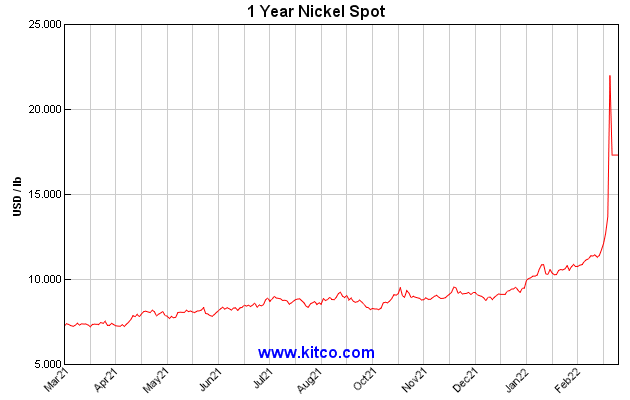
When a market moves sharply against “existing positions” (or existing sentiment), there is the possibility of a dramatically extended move – a “falling dominos” effect. Markets are currently extra sensitive to these “iceberg” risks; hence, we have lower liquidity and higher volatility.
FOMO (Fear Of Missing Out) orders are replaced by GMO (GET ME OUT) orders in a falling dominos market.
Arbitrage is a KEY market concept – if commodity prices are high in one location and cheap in another, traders will find a way to buy the cheap market and deliver into the higher-priced market to make a profit. (Think of US LNG headed for Europe.) But sanctions on Russia (and other effects of the war) have created a bifurcated market: commodities are cheaper in Russia and higher outside Russia, and traders can’t arb the difference. This “sets the table” for more commodity “blow-ups.”
Equities fell further this week without the hoped-for ceasefire
The Vanguard Total Stock Market ETF had its lowest weekly close in nearly a year – down ~14% from ATH in January.
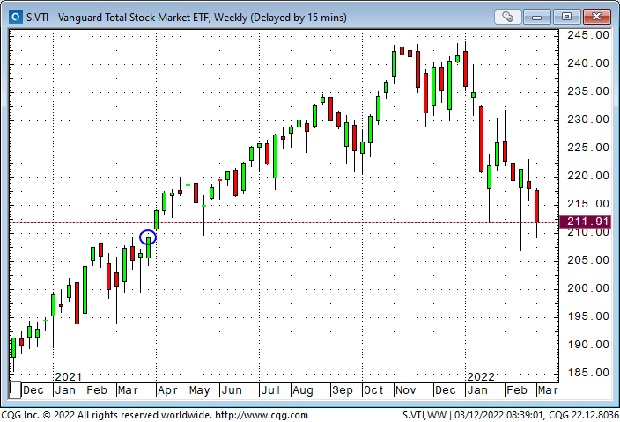
The Nasdaq Composite hit a 15 month low this week – down ~21% from November 2021 ATH.
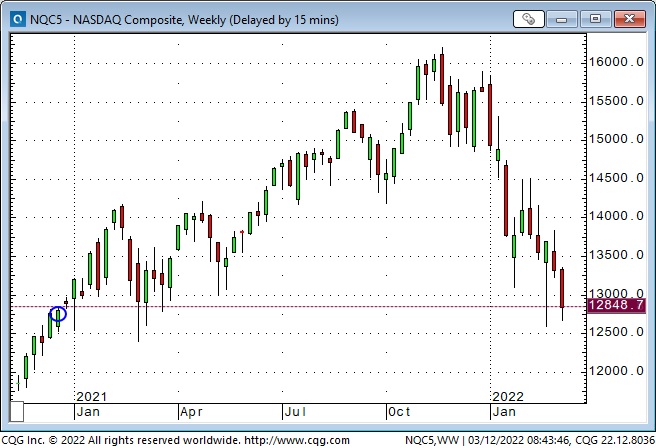
The PowerShares Chinese Technology Portfolio ETF fell to a 2-year low – down ~60% from Jan 2021 ATH.
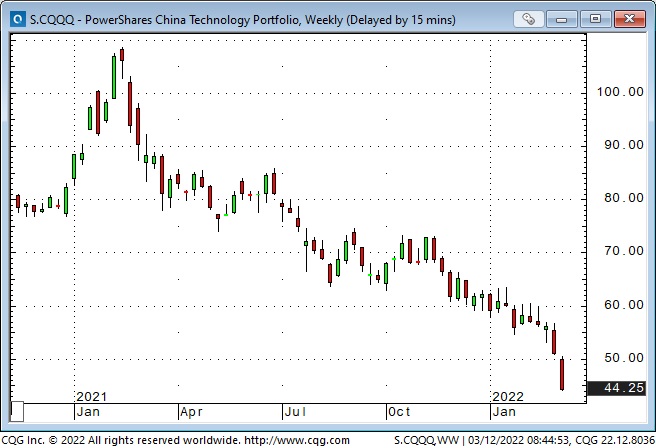
ARKK hit 22-month lows – down ~65% from Feb 2021 ATH.
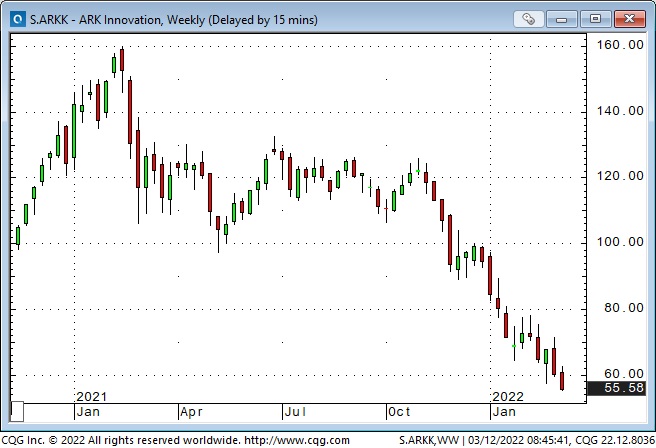
Implied volatility on S+P put options closed ~26% this week – the highest weekly close since the Covid panic two years ago.
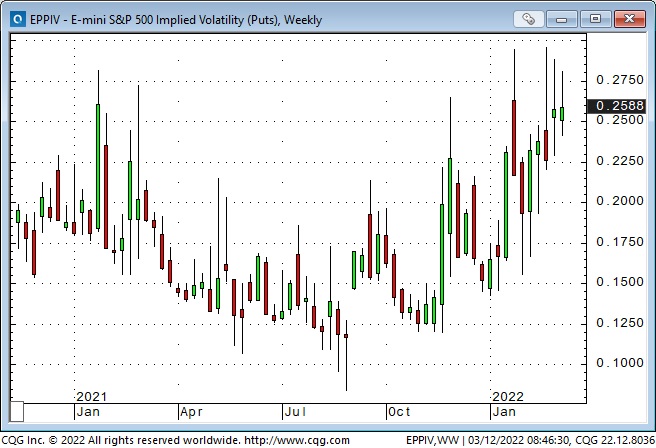
Equity market sentiment is currently very negative. If/when prices turn higher, the rally could be dramatic.
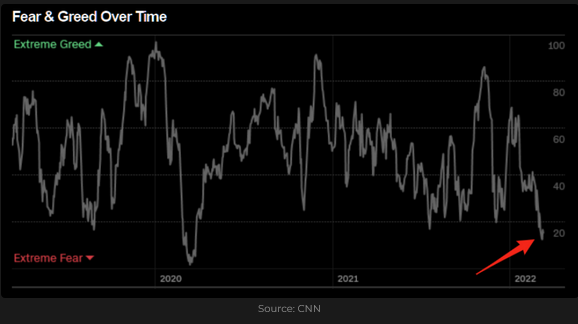
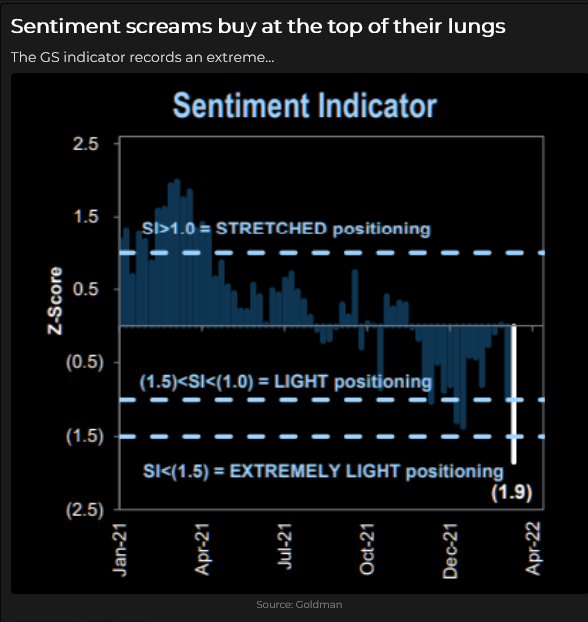
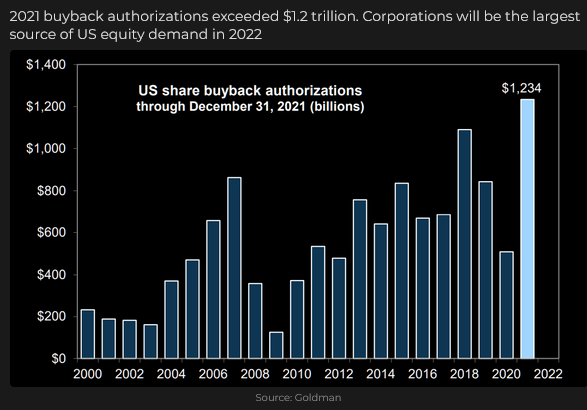
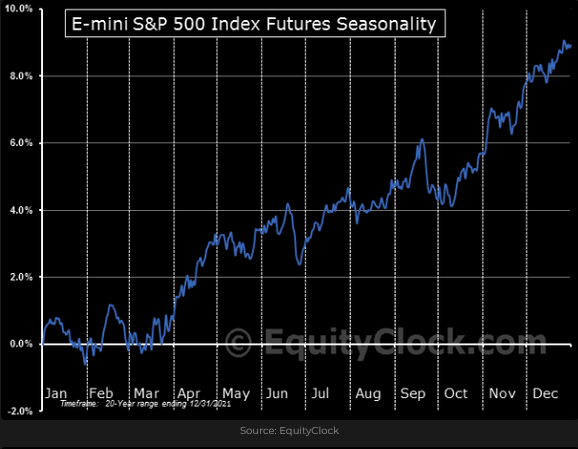
Gold hit All-Time Highs this week
Comex April gold futures hit $2078 on Monday but were $100 lower less than 24 hours later. At Monday’s high, gold was up ~$300 from the late January lows.
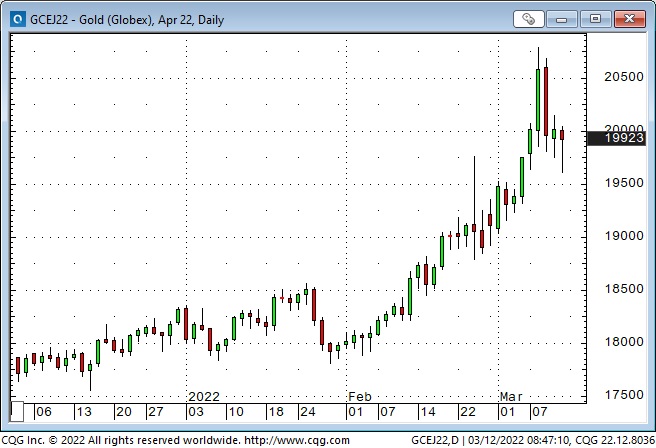
Newmont (the go-to gold investment for institutional accounts) rallied to an All-Time high of >$80 – up ~30% from early January lows.
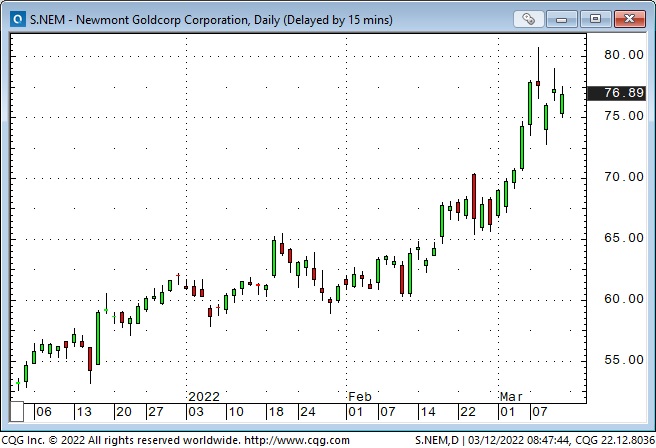
WTI crude oil hit $130, NYMEX Gasoline hit All-Time Highs
NYMEX front-month WTI surged to $100 on February 24th when the Russians invaded Ukraine but fell back to close the day ~$93 (expectations of a quick end to the conflict?) But in early March, prices surged from $95 to $130 as the consequences of sanctions and a prolonged war became apparent. Wild intra-day price swings took WTI down as much as $25 two days later.
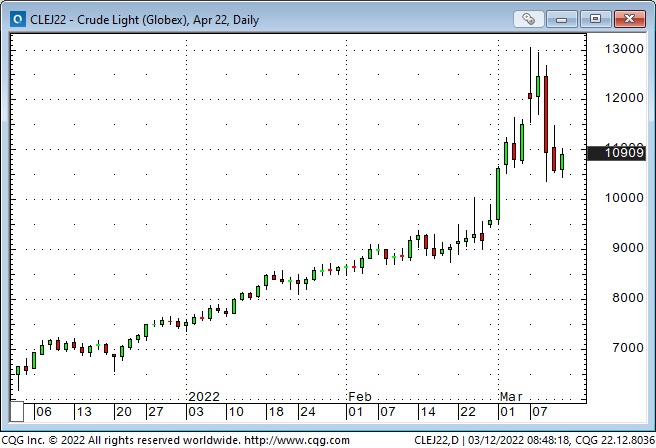
Implied Vol on WTI call options ranged between 50 and 100% this week. Yikes!
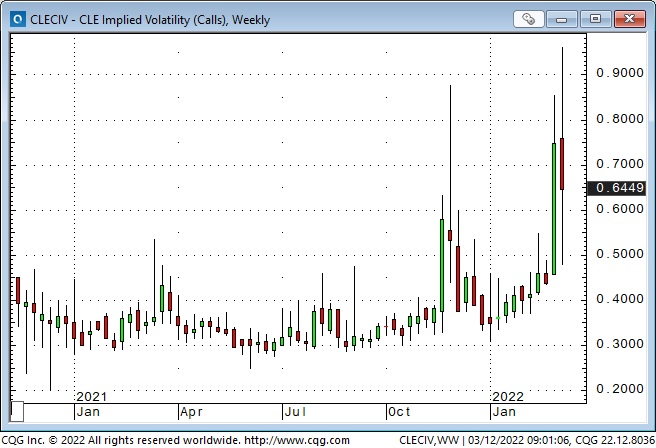
NYMEX RBOB gasoline had similar price action to WTI but briefly eclipsed the previous all-time high in 2008.
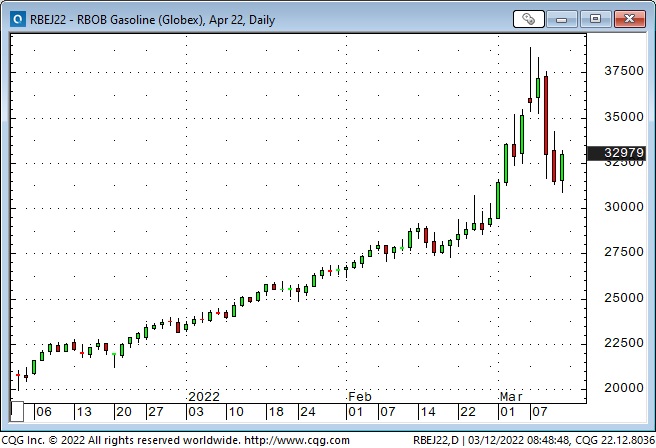
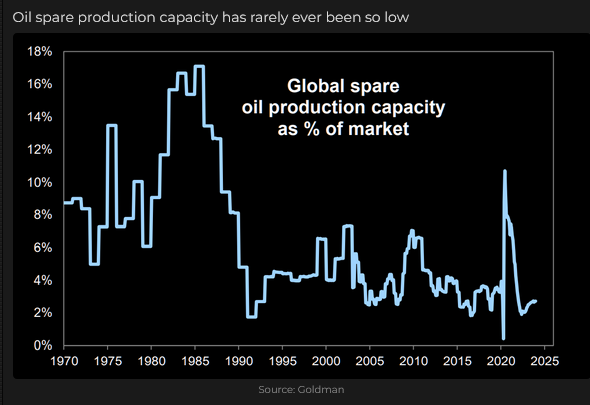
The public seems to be buying commodities aggressively. My long-time friend Ross Clark, who does terrific technical analysis, issued blow-off warnings for gold and commodities this week.
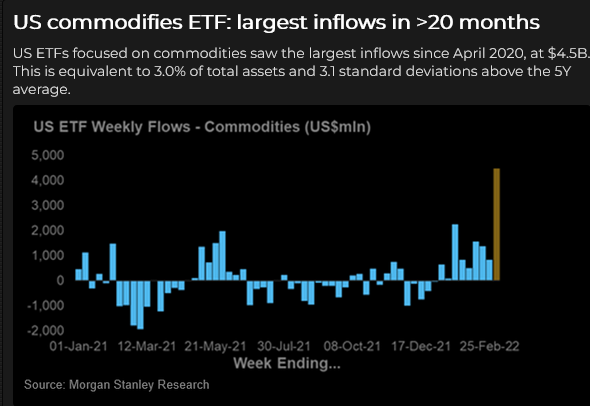
The US Dollar Index: highest weekly close in 22 months
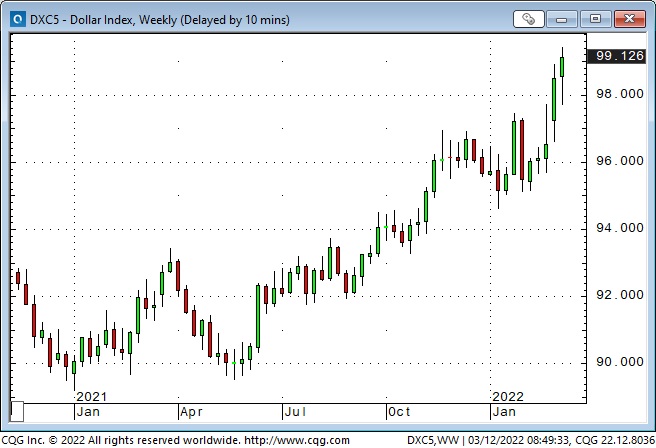
The Japanese Yen tumbled to its lowest weekly finish in over six years.
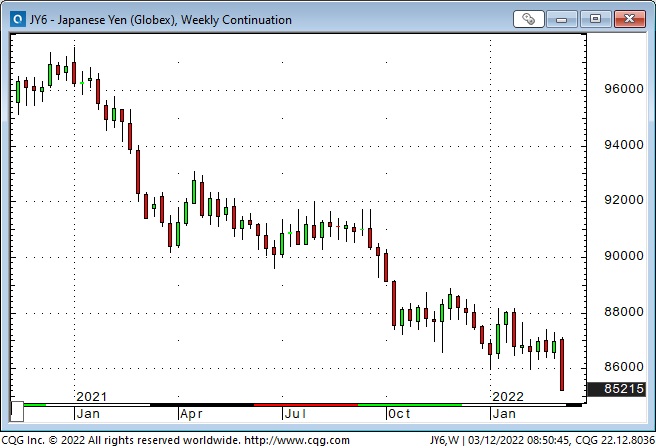
The offshore Renminbi hit its highest level against the USD in four years this week but weakened Friday as the USD rallied against most currencies. (In this chart, lower prices mean the USD is falling against the RMB.)
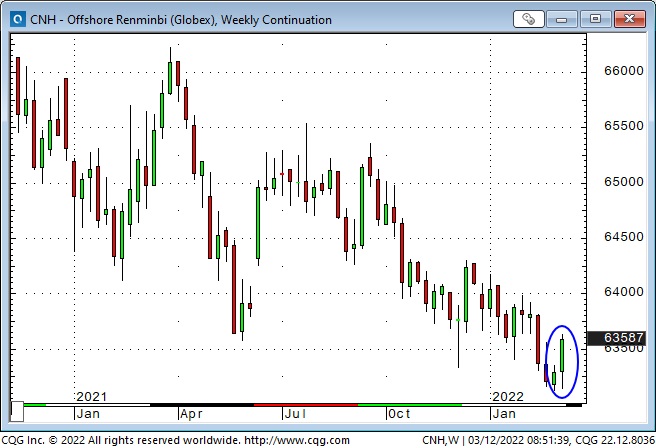
Russian Ruble futures have tumbled dramatically in the last three weeks – the Ruble is down ~80% from its July 2008 highs (when WTI was $147.)
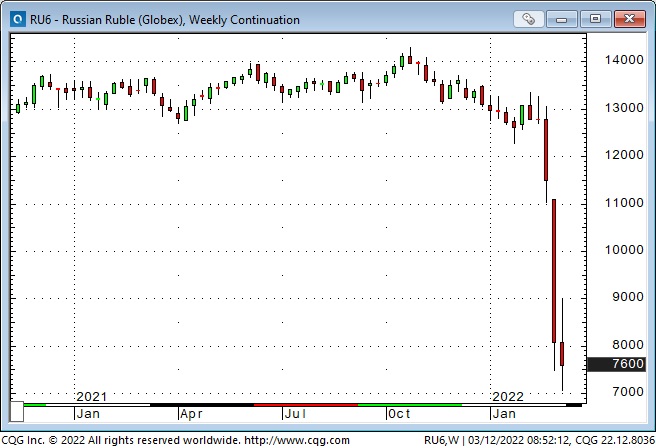
The Canadian Dollar
Last week I posed the question: “What’s wrong with the Loonie?” Commodities have been soaring, but the CAD has not been keeping pace. What’s the problem? My answer was that the USD has been super strong against virtually all other currencies and that (together with rising risk-off sentiment) trumped the bullish effect that increasing commodity prices usually have on the CAD.
This EURCAD chart shows that the Euro is at seven-year lows against the CAD.
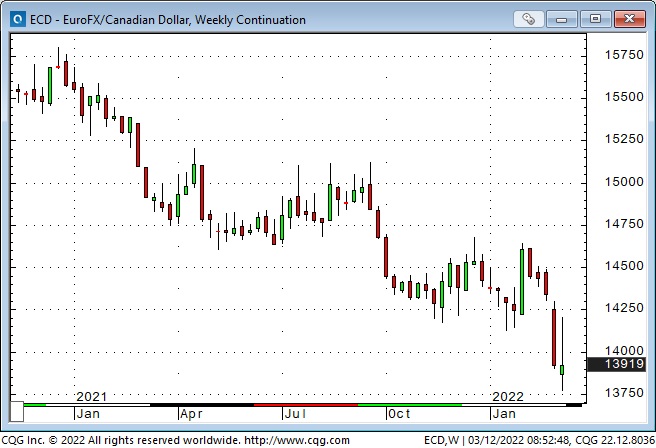
This chart shows that the reciprocal of the EURCAD (the rising black line is the CAD gaining on the Euro) has maintained a close correlation with the increasing CRBC commodity index (pink line.) So, In Euro terms, the CAD has been rising with commodities – in USD terms, not so much.
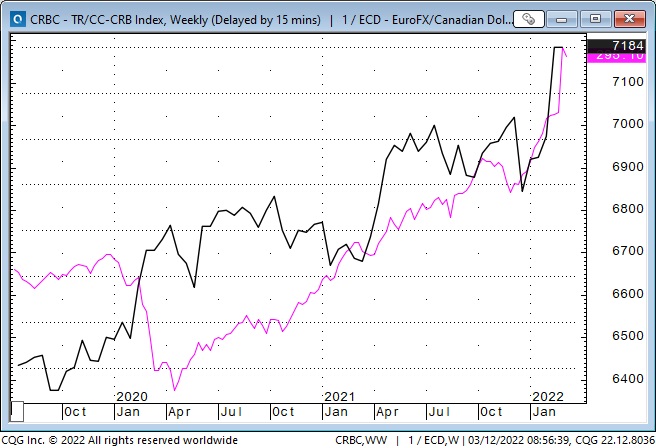
Expectations of Fed policy tightening have a more significant impact on US interest rates than the Russia/Ukraine conflict
American interest rates rose from December through February on expectations that the Fed would reverse ultra-easy monetary policies and start tightening in March 2022. Then Russia invaded Ukraine, and expectations briefly shifted to the Fed NOT tightening aggressively. But this week, sentiment turned back to the idea that the Fed will tighten policy because inflation will be even higher due to the invasion.
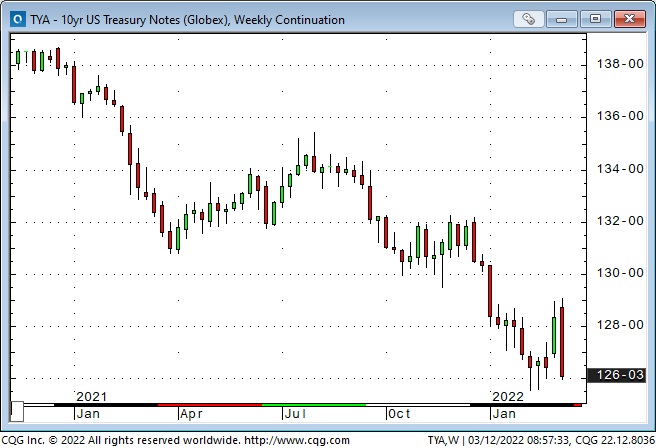
One-year forward Eurodollar contracts are pricing ~150 bp increase from current levels.
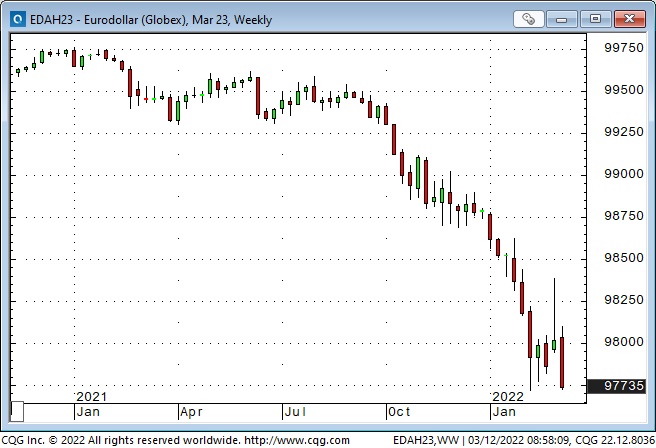
Credit quality spreads are widening as interest rates rise.
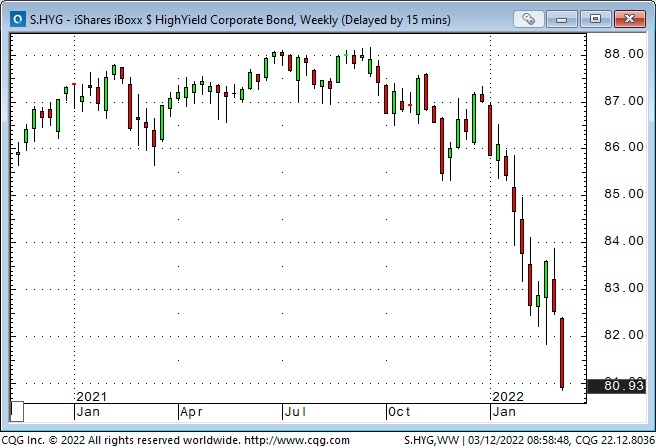
My short term trading
I was much more active this week than last week. My central theme was to try to pre-position ahead of a possible rally in the S+P (any indication of a ceasefire would cause stocks to soar.) I made several small-sized trades with tight stops. I had some winners and some losers, but net/net, I lost money.
I also bought the Euro and the CAD, thinking they would rally (after falling sharply last week) if there were any hint of a ceasefire. I made a little money on the Euro and was stopped for a slight loss on the CAD. I’m flat at the end of the week, and my P+L was down <0.50% on the week.
On my radar
ESG momentum may have stalled after being the “trendy” investment theme of 2021, but that doesn’t mean that long-term corporate Capex will surge because of higher energy prices. Corporations and investors will need to see a 180-degree change in attitude from Federal governments in North America before making serious long-term investments to develop domestic energy supplies. But Biden and Trudeau continue to be willfully oblivious to practical solutions that could make North American energy secure.
Regular readers know that my Big Picture thinking since last fall has been that equity markets are overdue for a substantial correction. I’ve written about “passive investing” (which now accounts for >50% of the new money coming into the market) being a relentless bid in the market. I think passive investors (who believe that the market only goes up over the long term) will NOT begin to sell unless the market has been trending lower for at least six months and the leading indices are down 30% or more.
Last week in the “Quotes” section, I quoted Michael Lewitt (The Credit Strategist) saying, “Wall Street’s job is to sell people things they should not buy. Like “short volatility!”
The ultra-low interest rate environment since 2008 has caused folks to “reach for yield” (to take more risk to generate income.) One of the things they have done is to sell option volatility and that selling depressed option Vol below where it would otherwise have been.
My guess (and my experience is that) unsophisticated option sellers will learn the hard way that they are taking too much risk, and that option Vols will trend higher as they leave the arena.
I first wrote about Fortress North America immediately after 9/11. My idea was that Canada, the USA and Mexico combined didn’t need much from the rest of the world.
That idea faded as globalization became the way of the world. Still, now that supply chain problems and geopolitical issues are generating thoughts of “on-shoring,” I wonder if the idea of a North American Bloc will re-surface (especially if China and Russia become best-of-friends.)
Thoughts on trading
People want to know “why” something happened – or will happen. They want a narrative that explains price action. For instance, crude oil is up because sanctions will reduce Russian supply. We’re told that if you’re going to be a good communicator, tell a story.
As a trader, I have to be aware that a narrative that “explains” price action may be deeply flawed or dead wrong. For instance, if I believe the story that “X” will cause “Y” to happen, and I make HUGE money betting on “Y” (without knowing that “X” had nothing to do with “Y”), then I’m at risk of thinking I can “see” things that other people can’t – that I have exceptional “variant perception.” That degree of hubris inevitably has painful consequences!
Trying to trade the “misinformation” flow from the Russia/Ukraine conflict is fraught with risk – especially if I’m predisposed to selectively choose the misinformation that supports my underlying bias (such as, “we must be close to a ceasefire!”)
Quotes from the notebook
“I acknowledge that I don’t have all the facts. I acknowledge that I don’t know what motivates other people participating in the markets that I trade. So why would price action in those markets have to “make sense” to me?” Victor Adair 2019
My comment: This kind of thinking is the basis of my risk management. I do not get stubborn with a trade that is going against me, and I never “give it a little more time.” I’m willing to take a slight loss and move on.
“It ain’t what you don’t know that gets you into trouble. It’s what you know “for sure” that just ain’t so…that gets you into trouble.” attributed to Mark Twain
My comment: 100%!
“In my darkest moments, Fanny, I’m afraid it’s all about marketing.” Victor Adair, during an unscripted TV interview with Fanny Kiefer, 2003
My comment: Fanny and I went back and forth about markets and human behaviour, and she got me to say the above quote. I had no idea I was going to say that – and once it was said, there was silence between us for a moment and then she faced the camera and said, “we will be right back after this commercial break.”
The Barney report
The Barns is six months old today. He’s forty-eight pounds and still growing. He’s asleep at my feet, but as soon as he wakes up, he will give me the “sad-face” until I leave my computers and play with him.
I love the way he prances along with his head up and his tail wagging when he’s found a good stick.

A Request
If you like reading the Trading Desk Notes, please forward a copy or a link to a friend. Also, I genuinely welcome your comments, and please let me know if you would like to see something new in the TD Notes.
Listen to Victor talk markets
I’ve had a regular weekly spot on Mike Campbell’s extremely popular Moneytalks show for 20 years. The March 12th podcast is available at: https://mikesmoneytalks.ca.
Victor Adair retired from the Canadian brokerage business in 2020 after 44 years and is no longer licensed to provide investment advice. Nothing on this website is investment advice for anyone about anything.

Russians are attempting to sell McDonald’s menu items online at highly inflated prices, following the closure of more than 800 restaurants in the country.
Insider viewed multiple listings on Avito, a Russian classified-ads website, which offered products including Big Macs and McMuffins. Avito is described on LinkedIn as the most popular classifieds site in Russia and the second-biggest in the world.
One Moscow-based seller advertised a Big Mac for the equivalent of around $36. The figure is based on exchange rates at time of writing. In Russia, the burger would usually cost 135 roubles, or around $1, according to The Economist’s Big Mac index.
Another seller recently posted a “McDonald’s Breakfast,” including McMuffins, potato pancakes, and sauces for around $18.
In a listing translated into English, the seller said they were offering the items to “those who want to enjoy the last taste of a bygone era.”…read more.

* Canadian dollar strengthens 0.2% against the greenback
* Canada adds 336,600 jobs in February
* Price of U.S. oil settles 3.1% higher
* Canadian 10-year yield touches a 3-year high at 2.006%
The Canadian dollar strengthened against its broadly stronger U.S. counterpart on Friday as domestic data showed a blockbuster jobs gain in February, helping to underpin expectations for another Bank of Canada interest rate hike next month.
The Canadian dollar strengthened 0.2% to 1.2740 per greenback, or 78.49 U.S. cents, after trading in a range of 1.2695 to 1.2794.
It was the only G10 currency to gain ground against the U.S. dollar.
“Today’s move is predicated by the employment report which was very robust,” said Amo Sahota, director at Klarity FX in San Francisco. “It keeps the Bank of Canada still very much on a tightening path.”
Canada added 336,600 jobs in February, more than double the 160,000 analysts had forecast, while the unemployment rate dropped below its pre-pandemic level for the first time as businesses reopened from strict Omicron restrictions…read more.


Each week Josef Schachter gives you his insights into global events, price forecasts and the fundamentals of the energy sector. Josef offers a twice monthly Black Gold newsletter covering the general energy market and 30 energy, energy service and pipeline & infrastructure companies with regular updates. We also hold quarterly webinars and provide Action BUY and SELL Alerts for paid subscribers. Learn more.
Russia/Ukraine War Update:
President Biden Tuesday, at the urging of both the parties in Congress, announced the cut-off by the US of all energy product imports (crude oil, crude products, LNG and coal) from Russia. This pushed the price of crude up. The recent high for WTI is US$130.50/b and today it is at $109.12/b (down US$14.58/b as I write this, and the daily price swing has been over US$20/b) on rumors of some unnamed OPEC country willing to increase supplies. If the Saudi’s don’t add supplies as they have the only large capacity left then this is just part of the daily volatility price swings. Crude prices are expected to continue to have large daily moves as the horror of the fighting in Ukraine escalates and more sanctions are imposed on Russia. In return, Russian retaliatory moves will impact prices. If Putin decides to use WMDs or cuts off some of the natural gas currently provided to Europe in spite, some pundits are calling for crude to rise over US$175/b. Even more dire forecasts have come from military experts who fear that the unbalanced President Putin could, in frustration with the lack of progress to capture Kiev and Kharkiv, use a low level tactical nuclear device on a small to medium Ukrainian city to force Ukraine’s government to surrender. They see Brent rising over US$200/b if this horrible event occurs. The first two weeks of the war have been devastating and genocidal (use of cluster bombs and bombing of civilian faciliites like hospitals and schools) but the worst is likely to come in the next few weeks. Once the mass migration of refugees has occurred (2M+ so far and expected to rise to over 5M in the coming weeks) Putin may unleash his fearsome’ total war’ phase as he did in Chechnya and Syria.
Putin is under pressure but even the lower energy volumes he can sell at discounts to willing buyers still provide Russia with high prices and large revenues in Yuan, gold and crypto due to the commodities’ significantly higher war prices.
EIA Weekly Oil Data: The EIA data of Wednesday March 9th was moderately bearish for energy prices but the price of WTI and Brent crude are reacting to the invasion by Russia. Bank of America forecasts that each 1Mb of crude oil product lost to the tight market means a $US20/b increase. With 3-4Mb of crude and products now unsaleable, the war premium is now $US60-80/b, or over half of the current price. They speculate that if 5Mb ends up being unsaleable as Europe joins the US embargo the price spike could take prices to over US$150/b.
US Commercial Crude Stocks fell 1.9Mb versus the forecast of a decline of 0.7Mb. Motor Gasoline Inventories fell 1.4Mb while Distillate Fuel Oil Inventories fell 5.2Mb. Refinery Utilization rose 1.6 points to 89.3% as refiners work to add more product for the energy shortage in the US and the world. Increased product could be sent to Europe to alleviate the tighter conditions there. US Crude Production remained steady at 11.6Mb. Gasoline prices have rocketed up to over US$7/gal in parts of the US, particularly in California. EVs are looking a lot more financially and fuel cost attractive to consumers. However, while the US industry is advertising a lot of new EVs they are still months or years away from availability. Selling prices for all cars are now above manufacturer’s recommended prices as dealers maximize profits from the low inventories in their showrooms.
Total Demand rose 381Kb/d to 21.21Mb/d as Other Oils demand rose 454Kb/d to 4.93Mb/d. Motor Gasoline demand rose 219Kb/d to 8.96Mb/d. Jet Fuel Consumption fell 117Kb/d to 1.35Mb/d. Cushing Crude Inventories fell 0.6Mb to 22.2Mb.
EIA Weekly Natural Gas Data: Weekly winter withdrawals continue. Last week’s data showed a withdrawal of 139 Bcf, lowering storage to 1.643 Tcf. The biggest US draws were in the Midwest (46 Bcf), the East (38 Bcf) and in South Central (35 Bcf).
The five-year average for last week was a withdrawal of 121 Bcf and in 2021 was 98 Bcf due to the warming weather and the end of winter consumption at the end of this month. April starts the new injection season. Storage is now 13.4% below the five-year average of 1,898 Tcf. Today NYMEX is US$4.53/mcf due to milder weather. AECO is trading at $4.75/mcf. After winter is over natural gas prices typically retreat and as the general stock market continues to decline, a great buying window should develop at much lower levels for natural gas stocks in Q3/22.
Baker Hughes Rig Data: The data for the week ending March 4th showed the US rig count unchanged at 650 rigs (up five rigs in the prior week). Of the total rigs working last week, 519 were drilling for oil and the rest were focused on natural gas activity. The overall US rig count is up 61% from 403 rigs working a year ago. The US oil rig count is up 67% from 310 rigs last year at this time. The natural gas rig count is up a more modest 41% from last year’s 92 rigs, now at 130 rigs.
Canada had a loss of seven rigs (up four rigs last week) to 217 rigs as springtime road bans halt most drilling. The rig count level will start falling sharply in the coming weeks. Only rigs staying on location drilling pad wells will be active shortly. Canadian activity is up 54% from 141 rigs last year. There was a four rig decrease for oil rigs and the count is now 134 oil rigs working. However this is up from 80 working at this time last year. There are 82 rigs (down three on the week) working on natural gas projects now, but still up from 61 rigs working last year. Staffing of rigs in Canada is still a problem and adding significantly more rigs this summer may be problematic. While rig and frack day rates are rising, so are costs and therefore margin improvements are not what one should expect as the industry activity picks up. Service industry margins need to rise materially in 2H/22 if drilling and completion activity is to rise.
The overall increase in rig activity from a year ago in both the US and Canada should translate into rising liquids and natural gas volumes over the coming months. The data from many companies’ plans for 2022 support this rising production profile expectation. We expect to see US crude oil production reaching 12.0Mb/d in the coming months. Companies are taking advantage of attractive drilling and completion costs and want to lock up experienced rigs, frack units and their crews as staffing issues are difficult for the sector. The EIA forecasts US production reaching 12.5Mb/d before the end of this year.
President Biden has not encouraged the US industry to solve the cut-off of Russian products by adding production of 750Kb/d as quickly as they can. He remains committed to his clean energy game plan which may take decades and US$Trillions to achieve. To meet the near-term problem of lack of supply in Europe he is not asking American energy companies to rise to the occasion but is working to get despotic and murderous regimes in Iran and Venezuela to provide the shortfall. His moral fiber on clean energy has been trumped by his desire to get much dirtier oil from autocratic countries. NUTS!
Conclusion:
Bullish pressure on crude prices:
- Russia’s invasion of Ukraine and the severe destruction of the country has rallied European nations against Russia. Even though imports into Europe of crude oil and natural gas are allowed, oil tanker companies are finding getting insurance difficult and have abandoned this business. Now only tankers owned by Russia, India and China handle the trade that can be done. Natural gas should not be impacted unless some of the current export pipelines are destroyed or Russia holds back supplies.
- Libya is having production problems again. How much volumes are down and for how long is yet unknown.
- Russia is now the most sanctioned country in the world, far exceeding the sanctions imposed on Iran and North Korea. Putin likely does not see a face-saving way out and may just increase his oppression, using WMDs including thermobaric bombs to flatten Ukraine. If he can’t capture the country he may just destroy it. The horrors of WWII are back in play.
- Saudi Arabia, UAE and Kuwait have not responded positively to President Biden’s pressure to increase production by 2-3Mb/d immediately. In the case of the Crown Prince of Saudi Arabia, Biden will not even talk to him (just to his father) as he calls him a pariah for the murder of his citizens and his flawed war in Yemen.
Bearish pressure on crude prices:
- The Iran nuclear negotiations are working towards sealing a deal and having sanctions removed so that they can sell their oil around the world. President Biden may be giving away more concessions to Iran in order to have sanctioned Iranian oil available. If a deal is concluded in the next week or so and Iran receives sanction relief, Iran could increase production by 1.3-1.5Mb/d immediately. Iran also has over 100Mb in floating storage around the world near its buyers and another 100Mb ready to sell.
- Venezuela appreciates the olive branch offered by the US and released two imprisoned Americans after their initial talks with US officials. Will this be a thaw in the relationship? Will the US just give them sanction relief but not require a unity government formed? It looks like barrels may win. Venezuela could increase production by over 2Mb/d but how quickly is not known due to the poor maintenance of their fields and infrastructure.
- The US and allies are releasing 60Mb of crude from their strategic reserves to meet short term needs. The US will supply 30Mb of the volumes to meet near term needs.
- The likelihood of a worldwide recession is rising. The high cost of energy is lowering consumers and industry capacity to handle. Many businesses are closing or limiting their hours in Europe. Food costs are exploding! Russia and Ukraine produce one-third of global wheat and barley production. Ukraine provides European livestock farmers with corn and other grain additives. None of this is being shipped now from the Black Sea ports. Nickel prices have exploded to the upside (doubled to US$100,000/ton) and the London Metal Exchange (LME) suspended trading and canceled trades as producers who presold production got margin calls that they couldn’t meet. This may be a multi-billion dollar disaster and could be the Lehman event of this financial and military crisis.
- Inflation will likely exceed 10% for CPI and PPI around the world and will box Central Banks in. Do they fight inflation by raising rates and lowering liquidity or do they provide accommodation during this war event. In either case the world faces a moderate or severe recession once hostilities end.
CONCLUSION:
The invasion of Ukraine has spiked up crude prices. In the end the higher energy prices will knock down demand 4-5Mb/d and we are likely to see recessions around the world later this year. If a worldwide recession unfolds, the price of crude could plunge sharply. One bank energy forecaster predicted today that we may see Brent exceed US$200/b in the coming weeks as the next painful phase of the war is initiated by Russia, but will fall rapidly to US$50/b once recessions take over. In 2008-2009 during the financial crisis demand fell by over 5Mb/d (from over 88Mb/d to 83Mb/d). The price of crude fell from US$147.27/b to US$33.55/b in eight months. During Iraq’s invasion of Kuwait prices rocketed from US$16.16/b in July 1990 to a high of US$41.15/b in October and then plunged in four months to US$17.45/b as recessionary demand destruction occurred.
Energy Stock Market: The stock markets around the world are gyrating with large daily price moves. Today the upside is 650 points (short covering rally day) for the Dow after the recent US sanction on Russian energy imports is applauded. The next move is Putin’s. Something bad (some kind of escalation by Tsar Putin) is about to happen in the coming days. The S&P/TSX Energy Index has retreated 3.7% today or over 8 points to the 216 level due to the sharp pullback in crude oil prices. Our energy sector has been benefiting from our attraction as a secure and safe supply source. The Canadian government is having chats about building LNG plants to provide natural gas to Europe but we are skeptical that this gets traction with the left -focused government agenda that needs the anti-energy industry NDP support to get anything done.
Our March Interim SER Report will be coming out next Thursday March 17th. It will include a detailed review of the economic impact and likely difficult recession the world will be facing in the coming months. Previous recessions after parabolic energy and other commodity inflationary price spikes have been severe and stock markets have been crushed. The current market declines are just the tip of the iceberg. Downside for the Dow Jones Industrials is the 24,000-25,000 during Q3/22 (today 33,300 – down from the high at the start of this year of 36,953). We expect violent market swings in the coming weeks with over 1,000 point down and up days for the Dow Jones Industrials as it works its way through this inflation and war induced bear market.
In our Interim report we go over in detail the financial and operating results of 13 companies that have reported. The financial results have been fabulous given the war premium in commodity prices. Our models have this windfall cash flow removed from Q3/22 data onward. Stocks are trading at or close to our one year targets so the upside is limited.
If you want access to this encompassing and timely market update report become a subscriber. Go to https://bit.ly/34iKcRt to subscribe.
Please feel free to forward our weekly ‘Eye on Energy’ to friends and colleagues. We always welcome new subscribers to our complimentary energy overview newsletter.














